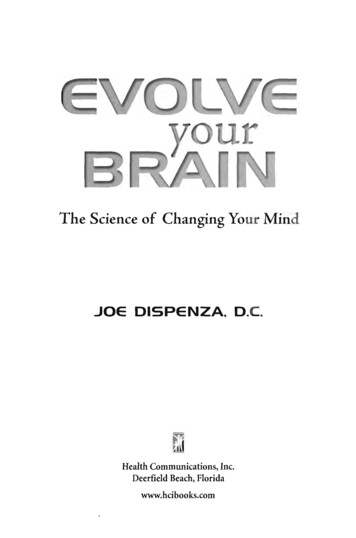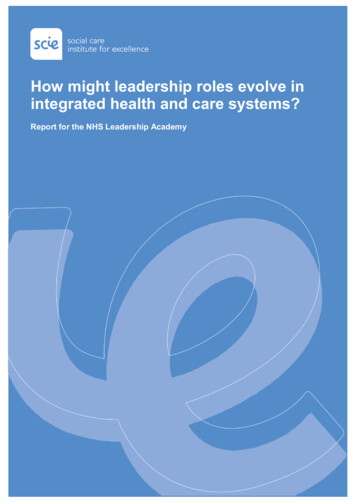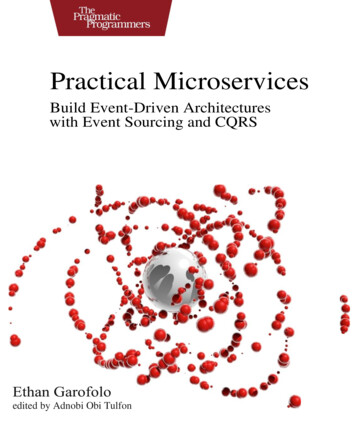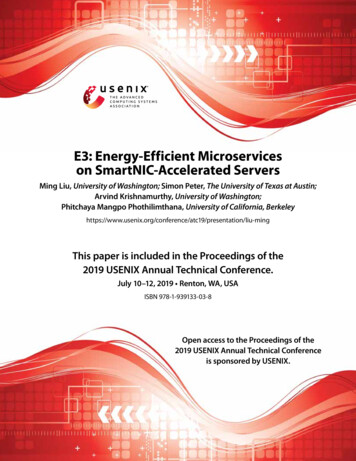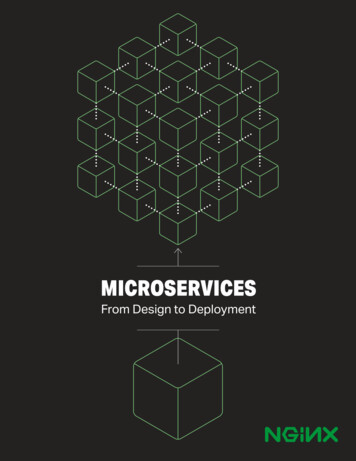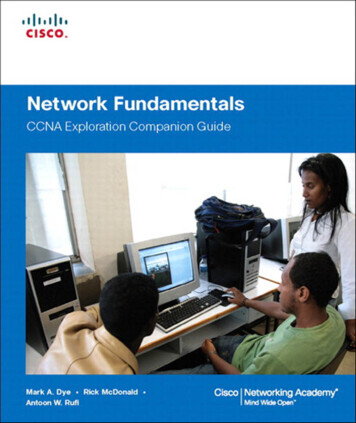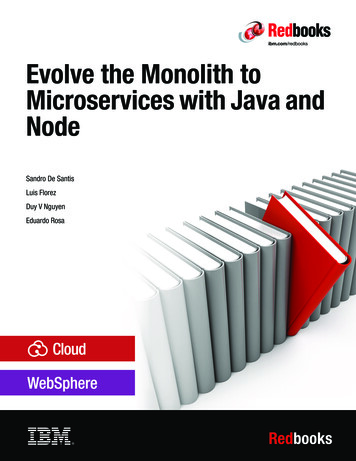
Transcription
0783442119Evolve the Monolith toMicroservices with Java andNodeSandro De SantisLuis FlorezDuy V NguyenEduardo RosaRedbooks
International Technical Support OrganizationEvolve the Monolith to Microservices with Java andNodeDecember 2016SG24-8358-00
Note: Before using this information and the product it supports, read the information in “Notices” onpage ix.First Edition (December 2016)This edition applies to IBM WebSphere Application Server Liberty V8.5.5, IBM API Connect V 5.0, IBMBluemix. Copyright International Business Machines Corporation 2016. All rights reserved.Note to U.S. Government Users Restricted Rights -- Use, duplication or disclosure restricted by GSA ADP ScheduleContract with IBM Corp.
iii
ivEvolve the Monolith to Microservices with Java and Node
ContentsNotices . . . . . . . . . . . . . . . . . . . . . . . . . . . . . . . . . . . . . . . . . . . . . . . . . . . . . . . . . . . . . . . . . ixTrademarks . . . . . . . . . . . . . . . . . . . . . . . . . . . . . . . . . . . . . . . . . . . . . . . . . . . . . . . . . . . . . . .xPreface . . . . . . . . . . . . . . . . . . . . . . . . . . . . . . . . . . . . . . . . . . . . . . . . . . . . . . . . . . . . . . . . . xiAuthors . . . . . . . . . . . . . . . . . . . . . . . . . . . . . . . . . . . . . . . . . . . . . . . . . . . . . . . . . . . . . . . . . . xiNow you can become a published author, too! . . . . . . . . . . . . . . . . . . . . . . . . . . . . . . . . . . xiiiComments welcome. . . . . . . . . . . . . . . . . . . . . . . . . . . . . . . . . . . . . . . . . . . . . . . . . . . . . . . xiiiStay connected to IBM Redbooks . . . . . . . . . . . . . . . . . . . . . . . . . . . . . . . . . . . . . . . . . . . . xiiiChapter 1. Overview of microservices . . . . . . . . . . . . . . . . . . . . . . . . . . . . . . . . . . . . . .1.1 What is the microservices architecture . . . . . . . . . . . . . . . . . . . . . . . . . . . . . . . . . . . . .1.1.1 Small and focused around business domain . . . . . . . . . . . . . . . . . . . . . . . . . . . .1.1.2 Technology neutral . . . . . . . . . . . . . . . . . . . . . . . . . . . . . . . . . . . . . . . . . . . . . . . .1.1.3 Loosely coupled . . . . . . . . . . . . . . . . . . . . . . . . . . . . . . . . . . . . . . . . . . . . . . . . . .1.1.4 Highly observable . . . . . . . . . . . . . . . . . . . . . . . . . . . . . . . . . . . . . . . . . . . . . . . . .1.1.5 Automation . . . . . . . . . . . . . . . . . . . . . . . . . . . . . . . . . . . . . . . . . . . . . . . . . . . . . .1.1.6 Bounded context . . . . . . . . . . . . . . . . . . . . . . . . . . . . . . . . . . . . . . . . . . . . . . . . . .1.2 Reasons for adopting the microservices architecture . . . . . . . . . . . . . . . . . . . . . . . . . .1.2.1 Challenges with existing monolithic applications . . . . . . . . . . . . . . . . . . . . . . . . .1.2.2 Microservices for various stakeholders . . . . . . . . . . . . . . . . . . . . . . . . . . . . . . . . .1.2.3 Timing with availability of cloud era and other tooling. . . . . . . . . . . . . . . . . . . . . .1.3 Transformation from a monolith to microservices . . . . . . . . . . . . . . . . . . . . . . . . . . . . .1.3.1 Fictional Company A business problem . . . . . . . . . . . . . . . . . . . . . . . . . . . . . . . .1.3.2 Adopting microservices for an evolutionary architecture. . . . . . . . . . . . . . . . . . . .151616161717181819192122232324Chapter 2. Evolution strategies . . . . . . . . . . . . . . . . . . . . . . . . . . . . . . . . . . . . . . . . . . . .2.1 Microservices: An evolutionary architecture by nature . . . . . . . . . . . . . . . . . . . . . . . . .2.2 Evolutionary practices and patterns . . . . . . . . . . . . . . . . . . . . . . . . . . . . . . . . . . . . . . .2.2.1 Continuous integration, continuous delivery . . . . . . . . . . . . . . . . . . . . . . . . . . . . .2.2.2 Strangler application . . . . . . . . . . . . . . . . . . . . . . . . . . . . . . . . . . . . . . . . . . . . . . .2.2.3 Evolutionary database refactoring and deployment . . . . . . . . . . . . . . . . . . . . . . .2.3 Evolutionary architecture in practice . . . . . . . . . . . . . . . . . . . . . . . . . . . . . . . . . . . . . . .2.3.1 Gradually transforming to a catalog service . . . . . . . . . . . . . . . . . . . . . . . . . . . . .2.3.2 Strangling the customer and order components . . . . . . . . . . . . . . . . . . . . . . . . . .2.3.3 Evolutionarily transforming the user interface to a UI microservice . . . . . . . . . . .27283030303132333334Chapter 3. Identifying candidates within the monolith . . . . . . . . . . . . . . . . . . . . . . . . .3.1 Identifying candidates . . . . . . . . . . . . . . . . . . . . . . . . . . . . . . . . . . . . . . . . . . . . . . . . . .3.2 Considerations for moving to microservices . . . . . . . . . . . . . . . . . . . . . . . . . . . . . . . . .3.3 Decomposing monolith application into microservices . . . . . . . . . . . . . . . . . . . . . . . . .3.3.1 Designing microservices . . . . . . . . . . . . . . . . . . . . . . . . . . . . . . . . . . . . . . . . . . . .3.3.2 Choosing the implementation stack . . . . . . . . . . . . . . . . . . . . . . . . . . . . . . . . . . .3.3.3 Sizing the microservices . . . . . . . . . . . . . . . . . . . . . . . . . . . . . . . . . . . . . . . . . . . .3.4 Refactoring . . . . . . . . . . . . . . . . . . . . . . . . . . . . . . . . . . . . . . . . . . . . . . . . . . . . . . . . . .3.4.1 A reason to refactor to microservices . . . . . . . . . . . . . . . . . . . . . . . . . . . . . . . . . .3.4.2 Strategies for moving to microservices . . . . . . . . . . . . . . . . . . . . . . . . . . . . . . . . .3.4.3 How to refactor Java EE to microservices . . . . . . . . . . . . . . . . . . . . . . . . . . . . . .3.5 Identifying and creating a new architecture example . . . . . . . . . . . . . . . . . . . . . . . . . .3.5.1 Architecture: As is . . . . . . . . . . . . . . . . . . . . . . . . . . . . . . . . . . . . . . . . . . . . . . . . .35363637384041424242434646 Copyright IBM Corp. 2016. All rights reserved.v
3.5.2 Architecture: To be . . . . . . . . . . . . . . . . . . . . . . . . . . . . . . . . . . . . . . . . . . . . . . . . 47Chapter 4. Enterprise data access patterns . . . . . . . . . . . . . . . . . . . . . . . . . . . . . . . . . .4.1 Distributed data management . . . . . . . . . . . . . . . . . . . . . . . . . . . . . . . . . . . . . . . . . . . .4.2 New challenges . . . . . . . . . . . . . . . . . . . . . . . . . . . . . . . . . . . . . . . . . . . . . . . . . . . . . . .4.2.1 Data consistency. . . . . . . . . . . . . . . . . . . . . . . . . . . . . . . . . . . . . . . . . . . . . . . . . .4.2.2 Communication between microservices . . . . . . . . . . . . . . . . . . . . . . . . . . . . . . . .4.3 Integration with the monolith application . . . . . . . . . . . . . . . . . . . . . . . . . . . . . . . . . . . .4.3.1 Modifying the monolith application . . . . . . . . . . . . . . . . . . . . . . . . . . . . . . . . . . . .4.4 Which database technology to use . . . . . . . . . . . . . . . . . . . . . . . . . . . . . . . . . . . . . . . .4.4.1 Relational databases . . . . . . . . . . . . . . . . . . . . . . . . . . . . . . . . . . . . . . . . . . . . . .4.4.2 NoSQL databases. . . . . . . . . . . . . . . . . . . . . . . . . . . . . . . . . . . . . . . . . . . . . . . . .4.5 Practical example: Creating the new microservices . . . . . . . . . . . . . . . . . . . . . . . . . . .4.5.1 New microservice catalog search . . . . . . . . . . . . . . . . . . . . . . . . . . . . . . . . . . . . .4.5.2 Evolution of the account data model . . . . . . . . . . . . . . . . . . . . . . . . . . . . . . . . . . .51525252586161616162636374Chapter 5. Security and governance . . . . . . . . . . . . . . . . . . . . . . . . . . . . . . . . . . . . . . . .5.1 Security in microservice architecture . . . . . . . . . . . . . . . . . . . . . . . . . . . . . . . . . . . . . .5.1.1 Authentication and authorization. . . . . . . . . . . . . . . . . . . . . . . . . . . . . . . . . . . . . .5.1.2 Service-to-service authentication and authorization . . . . . . . . . . . . . . . . . . . . . . .5.1.3 Data security . . . . . . . . . . . . . . . . . . . . . . . . . . . . . . . . . . . . . . . . . . . . . . . . . . . . .5.1.4 Defence in depth . . . . . . . . . . . . . . . . . . . . . . . . . . . . . . . . . . . . . . . . . . . . . . . . . .5.2 Governance in microservice architecture . . . . . . . . . . . . . . . . . . . . . . . . . . . . . . . . . . .5.3 The case study . . . . . . . . . . . . . . . . . . . . . . . . . . . . . . . . . . . . . . . . . . . . . . . . . . . . . . .5.3.1 Integrating and securing the monolith system. . . . . . . . . . . . . . . . . . . . . . . . . . . .5.4 Summary . . . . . . . . . . . . . . . . . . . . . . . . . . . . . . . . . . . . . . . . . . . . . . . . . . . . . . . . . . . .81828283848586868792Chapter 6. Performance . . . . . . . . . . . . . . . . . . . . . . . . . . . . . . . . . . . . . . . . . . . . . . . . . . 956.1 Common problems . . . . . . . . . . . . . . . . . . . . . . . . . . . . . . . . . . . . . . . . . . . . . . . . . . . . 966.2 Antipatterns to avoid . . . . . . . . . . . . . . . . . . . . . . . . . . . . . . . . . . . . . . . . . . . . . . . . . . . 976.2.1 N 1 service call pattern . . . . . . . . . . . . . . . . . . . . . . . . . . . . . . . . . . . . . . . . . . . . 976.2.2 Excessive service calls . . . . . . . . . . . . . . . . . . . . . . . . . . . . . . . . . . . . . . . . . . . . . 986.2.3 Garrulous services . . . . . . . . . . . . . . . . . . . . . . . . . . . . . . . . . . . . . . . . . . . . . . . . 996.2.4 Lack of caching . . . . . . . . . . . . . . . . . . . . . . . . . . . . . . . . . . . . . . . . . . . . . . . . . . 1006.3 Lead practices to improve performance . . . . . . . . . . . . . . . . . . . . . . . . . . . . . . . . . . . 1006.3.1 Let the service own its operational data . . . . . . . . . . . . . . . . . . . . . . . . . . . . . . . 1006.3.2 Avoid chatty security enforcement . . . . . . . . . . . . . . . . . . . . . . . . . . . . . . . . . . . 1006.3.3 Leverage messaging and REST . . . . . . . . . . . . . . . . . . . . . . . . . . . . . . . . . . . . . 1006.3.4 Fail fast and gracefully . . . . . . . . . . . . . . . . . . . . . . . . . . . . . . . . . . . . . . . . . . . . 102Chapter 7. DevOps and automation . . . . . . . . . . . . . . . . . . . . . . . . . . . . . . . . . . . . . . .7.1 Deployment automation . . . . . . . . . . . . . . . . . . . . . . . . . . . . . . . . . . . . . . . . . . . . . . .7.1.1 Development . . . . . . . . . . . . . . . . . . . . . . . . . . . . . . . . . . . . . . . . . . . . . . . . . . . .7.1.2 Build . . . . . . . . . . . . . . . . . . . . . . . . . . . . . . . . . . . . . . . . . . . . . . . . . . . . . . . . . .7.1.3 Test . . . . . . . . . . . . . . . . . . . . . . . . . . . . . . . . . . . . . . . . . . . . . . . . . . . . . . . . . . .7.1.4 Deploy . . . . . . . . . . . . . . . . . . . . . . . . . . . . . . . . . . . . . . . . . . . . . . . . . . . . . . . . .7.2 Monitoring . . . . . . . . . . . . . . . . . . . . . . . . . . . . . . . . . . . . . . . . . . . . . . . . . . . . . . . . . .7.2.1 Collecting data . . . . . . . . . . . . . . . . . . . . . . . . . . . . . . . . . . . . . . . . . . . . . . . . . .7.2.2 Dashboard . . . . . . . . . . . . . . . . . . . . . . . . . . . . . . . . . . . . . . . . . . . . . . . . . . . . .7.2.3 Error handling . . . . . . . . . . . . . . . . . . . . . . . . . . . . . . . . . . . . . . . . . . . . . . . . . . .7.3 Performance . . . . . . . . . . . . . . . . . . . . . . . . . . . . . . . . . . . . . . . . . . . . . . . . . . . . . . . .7.3.1 Automatic scalability . . . . . . . . . . . . . . . . . . . . . . . . . . . . . . . . . . . . . . . . . . . . . .7.3.2 Service discovery . . . . . . . . . . . . . . . . . . . . . . . . . . . . . . . . . . . . . . . . . . . . . . . .7.3.3 Load balancing . . . . . . . . . . . . . . . . . . . . . . . . . . . . . . . . . . . . . . . . . . . . . . . . . .viEvolve the Monolith to Microservices with Java and Node103104104104108109112112113114115115117117
Appendix A. Additional material . . . . . . . . . . . . . . . . . . . . . . . . . . . . . . . . . . . . . . . . . .Locating the Web material . . . . . . . . . . . . . . . . . . . . . . . . . . . . . . . . . . . . . . . . . . . . . . . . .Cloning the GitHub repository . . . . . . . . . . . . . . . . . . . . . . . . . . . . . . . . . . . . . . . . . . . . . .Social networks JSON data model example . . . . . . . . . . . . . . . . . . . . . . . . . . . . . . . . . . .119119119119Related publications . . . . . . . . . . . . . . . . . . . . . . . . . . . . . . . . . . . . . . . . . . . . . . . . . . . .Other publications . . . . . . . . . . . . . . . . . . . . . . . . . . . . . . . . . . . . . . . . . . . . . . . . . . . . . . .Online resources . . . . . . . . . . . . . . . . . . . . . . . . . . . . . . . . . . . . . . . . . . . . . . . . . . . . . . . .Help from IBM . . . . . . . . . . . . . . . . . . . . . . . . . . . . . . . . . . . . . . . . . . . . . . . . . . . . . . . . . .125125125125Contentsvii
viiiEvolve the Monolith to Microservices with Java and Node
NoticesThis information was developed for products and services offered in the US. This material might be availablefrom IBM in other languages. However, you may be required to own a copy of the product or product version inthat language in order to access it.IBM may not offer the products, services, or features discussed in this document in other countries. Consultyour local IBM representative for information on the products and services currently available in your area. Anyreference to an IBM product, program, or service is not intended to state or imply that only that IBM product,program, or service may be used. Any functionally equivalent product, program, or service that does notinfringe any IBM intellectual property right may be used instead. However, it is the user's responsibility toevaluate and verify the operation of any non-IBM product, program, or service.IBM may have patents or pending patent applications covering subject matter described in this document. Thefurnishing of this document does not grant you any license to these patents. You can send license inquiries, inwriting, to:IBM Director of Licensing, IBM Corporation, North Castle Drive, MD-NC119, Armonk, NY 10504-1785, USINTERNATIONAL BUSINESS MACHINES CORPORATION PROVIDES THIS PUBLICATION “AS IS”WITHOUT WARRANTY OF ANY KIND, EITHER EXPRESS OR IMPLIED, INCLUDING, BUT NOT LIMITEDTO, THE IMPLIED WARRANTIES OF NON-INFRINGEMENT, MERCHANTABILITY OR FITNESS FOR APARTICULAR PURPOSE. Some jurisdictions do not allow disclaimer of express or implied warranties incertain transactions, therefore, this statement may not apply to you.This information could include technical inaccuracies or typographical errors. Changes are periodically madeto the information herein; these changes will be incorporated in new editions of the publication. IBM may makeimprovements and/or changes in the product(s) and/or the program(s) described in this publication at any timewithout notice.Any references in this information to non-IBM websites are provided for convenience only and do not in anymanner serve as an endorsement of those websites. The materials at those websites are not part of thematerials for this IBM product and use of those websites is at your own risk.IBM may use or distribute any of the information you provide in any way it believes appropriate withoutincurring any obligation to you.The performance data and client examples cited are presented for illustrative purposes only. Actualperformance results may vary depending on specific configurations and operating conditions.Information concerning non-IBM products was obtained from the suppliers of those products, their publishedannouncements or other publicly available sources. IBM has not tested those products and cannot confirm theaccuracy of performance, compatibility or any other claims related to non-IBM products. Questions on thecapabilities of non-IBM products should be addressed to the suppliers of those products.Statements regarding IBM's future direction or intent are subject to change or withdrawal without notice, andrepresent goals and objectives only.This information contains examples of data and reports used in daily business operations. To illustrate themas completely as possible, the examples include the names of individuals, companies, brands, and products.All of these names are fictitious and any similarity to actual people or business enterprises is entirelycoincidental.COPYRIGHT LICENSE:This information contains sample application programs in source language, which illustrate programmingtechniques on various operating platforms. You may copy, modify, and distribute these sample programs inany form without payment to IBM, for the purposes of developing, using, marketing or distributing applicationprograms conforming to the application programming interface for the operating platform for which the sampleprograms are written. These examples have not been thoroughly tested under all conditions. IBM, therefore,cannot guarantee or imply reliability, serviceability, or function of these programs. The sample programs areprovided “AS IS”, without warranty of any kind. IBM shall not be liable for any damages arising out of your useof the sample programs. Copyright IBM Corp. 2016. All rights reserved.ix
TrademarksIBM, the IBM logo, and ibm.com are trademarks or registered trademarks of International Business MachinesCorporation, registered in many jurisdictions worldwide. Other product and service names might betrademarks of IBM or other companies. A current list of IBM trademarks is available on the web at “Copyrightand trademark information” at http://www.ibm.com/legal/copytrade.shtmlThe following terms are trademarks or registered trademarks of International Business Machines Corporation,and might also be trademarks or registered trademarks in other countries.Bluemix Cloudant Concert DataPower DataStage DB2 developerWorks IBM IBM API Connect IBM Watson PureApplication Rational Redbooks Redbooks (logo)Terraform WebSphere The following terms are trademarks of other companies:Evolution, and Inc. device are trademarks or registered trademarks of Kenexa, an IBM Company.SoftLayer, and SoftLayer device are trademarks or registered trademarks of SoftLayer, Inc., an IBM Company.Linux is a trademark of Linus Torvalds in the United States, other countries, or both.Java, and all Java-based trademarks and logos are trademarks or registered trademarks of Oracle and/or itsaffiliates.UNIX is a registered trademark of The Open Group in the United States and other countries.Other company, product, or service names may be trademarks or service marks of others.xEvolve the Monolith to Microservices with Java and Node
PrefaceMicroservices is an architectural style in which large, complex software applications arecomposed of one or more smaller services. Each of these microservices focuses oncompleting one task that represents a small business capability. These microservices can bedeveloped in any programming language.This IBM Redbooks publication shows how to break out a traditional Java EE applicationinto separate microservices and provides a set of code projects that illustrate the varioussteps along the way. These code projects use the IBM WebSphere Application ServerLiberty, IBM API Connect , IBM Bluemix , and other Open Source Frameworks in themicroservices ecosystem. The sample projects highlight the evolution of monoliths tomicroservices with Java and Node.AuthorsThis book was produced by a team of specialists from around the world working at theInternational Technical Support Organization, Raleigh Center.Sandro De Santis is an IT Architect in Brazil. He joined IBM in2011. Be
xii Evolve the Monolith to Microservices with Java and Node This project was led by: Margaret Ticknor an IBM
